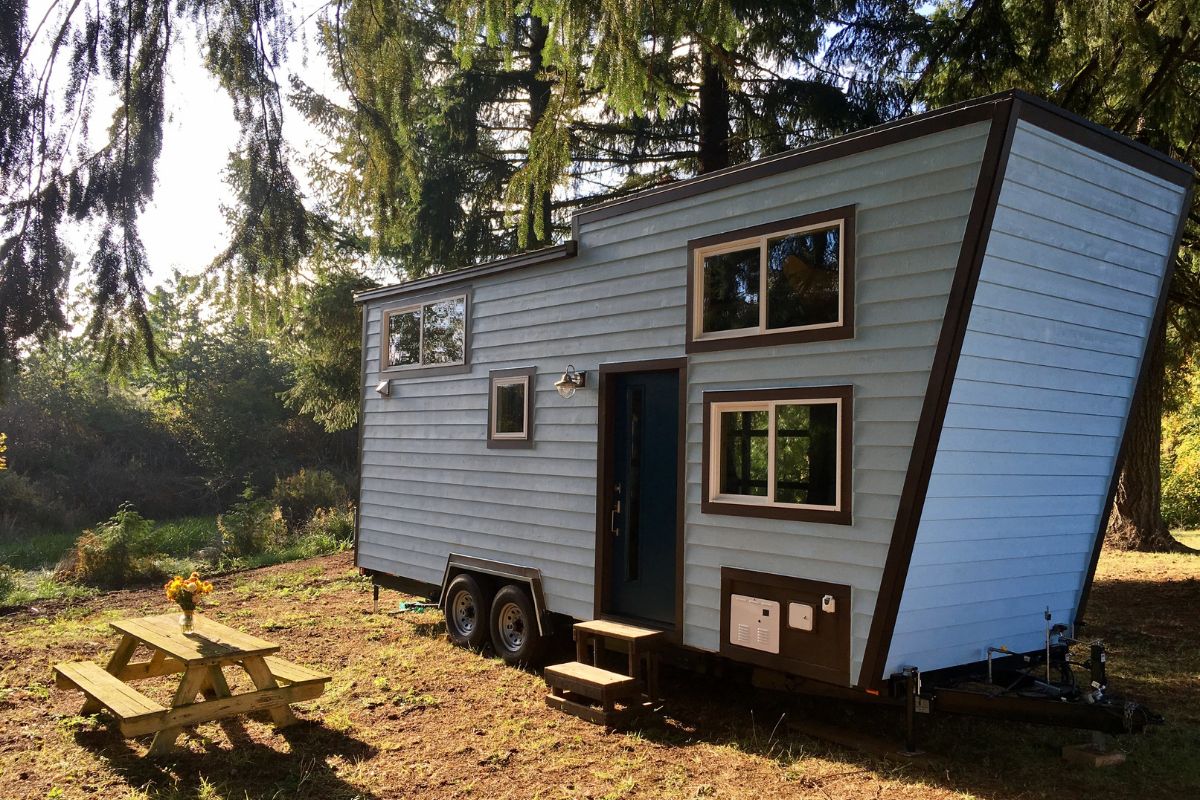When building your tiny house, choosing the right materials is key for both durability and sustainability. Opt for reclaimed or recycled materials to reduce waste, and for insulation, consider eco-friendly options like sheep's wool or cellulose. Select lightweight, decay-resistant woods like cedar for the structure, and hardwoods like oak for flooring.
Metal roofing is popular for its energy efficiency, while energy-efficient windows and doors lower energy consumption. For flooring, bamboo and cork offer stylish, eco-friendly alternatives. Each choice impacts your home's comfort and environmental footprint. There's plenty more to explore about these materials and their benefits.
Key Takeaways
- Choose reclaimed or recycled materials to minimize waste and add unique character to your tiny house.
- Opt for non-toxic insulation options like sheep's wool or recycled denim for better energy efficiency and indoor air quality.
- Select low-VOC paints and natural sealants to create a healthier living environment inside your tiny home.
- Consider energy-efficient windows and doors to significantly reduce energy consumption and improve comfort.
- Use durable and lightweight wood types, like cedar or pine, for construction and aesthetic appeal in limited spaces.
Choosing Sustainable Materials
When you're building a tiny house, choosing sustainable materials is crucial for minimizing your environmental impact and creating a cozy, eco-friendly space. Start by considering reclaimed or recycled materials, which not only reduce waste but also add character to your home. Look for non-toxic insulation options, like sheep's wool or recycled denim, that improve energy efficiency while keeping your indoor air clean. You might also explore sustainably sourced finishes, such as low-VOC paints and natural sealants, to guarantee a healthier living environment.

Don't forget about energy-efficient windows and doors, which can greatly decrease your energy consumption. By prioritizing these materials, you're making a positive choice for both your home and the planet, ensuring your tiny house aligns with your eco-conscious lifestyle.
Wood Options for Tiny Houses
Although selecting the right wood can seem overwhelming, it's essential for creating a sturdy and inviting tiny house. Start by considering softwoods like pine or cedar for framing and siding; they're lightweight and easier to work with. Cedar's natural resistance to decay makes it a popular choice for exterior applications.
If you prefer hardwoods, oak and maple offer durability and a beautiful finish, perfect for flooring or cabinetry. Reclaimed wood can add character while being eco-friendly, but verify it's treated properly to avoid pests. Don't forget about plywood and oriented strand board (OSB) for structural panels—they're cost-effective and strong. Choose wood that fits your style and budget, and you'll create a cozy, well-built tiny home you'll love.
Insulation Choices
Choosing the right insulation is essential for maintaining a comfortable temperature in your tiny house, especially since space is limited and energy efficiency is key. You'll have several options, each with its own benefits. Fiberglass batts are popular for their affordability and ease of installation, but make sure to handle them carefully to avoid irritation.
Spray foam provides superior insulation and seals gaps effectively, though it can be pricier. For a sustainable choice, consider cellulose made from recycled paper; it's eco-friendly and offers good thermal performance. Reflective insulation can also help, especially in warmer climates, by reflecting heat away. Assess your climate, budget, and personal preferences to choose the best insulation that fits your tiny home lifestyle.

Eco-Friendly Flooring Solutions
As you consider flooring options for your tiny house, eco-friendly solutions can provide both aesthetic appeal and sustainability. Bamboo flooring is a popular choice due to its rapid growth and durability. It's not only stylish but also resistant to moisture, making it ideal for small spaces. Reclaimed wood is another fantastic option; it adds character while reducing waste.
If you're looking for something more modern, consider cork, which's renewable and offers great insulation properties. Linoleum, made from natural materials, is another eco-friendly alternative that's easy to maintain. Whichever option you choose, guarantee it's free from harmful chemicals to promote a healthier living environment. Eco-friendly flooring can enhance your tiny home's charm while supporting your commitment to sustainability.
Roofing Materials Overview
When designing your tiny house, the roofing materials you select play a significant role in both functionality and style. You'll want to take into account options like metal, asphalt shingles, or even green roofs. Metal roofing is durable and energy-efficient, making it a popular choice for tiny homes.
Asphalt shingles are cost-effective and come in various colors, giving you flexibility in aesthetics. Green roofs not only provide insulation but also promote sustainability and biodiversity. Don't forget about weight; lighter materials are easier to support on smaller structures. Make sure your choice can withstand your local climate, providing durability against elements like snow or heavy rain. Ultimately, your roofing material should reflect your personal style while serving practical purposes.
Windows and Doors Selection
How do you decide on the right windows and doors for your tiny house? Start by considering the size and style of your space. Opt for larger windows to maximize natural light and create an open feel. Look for energy-efficient models that offer good insulation, helping you save on heating and cooling costs.
When it comes to doors, choose ones that enhance security and durability. Sliding or bi-fold doors can save space while providing easy access to outdoor areas. Don't forget about aesthetics—select designs that complement your overall style. Finally, think about maintenance; materials like vinyl or fiberglass require less upkeep than wood. With careful selection, your windows and doors will enhance both functionality and beauty in your tiny home.
Plumbing and Electrical Components
Plumbing and electrical components are the lifelines of your tiny house, ensuring comfort and convenience in your compact living space. When planning your plumbing, consider using PEX piping, which is flexible and easy to install. Don't forget to include a compact water heater and efficient fixtures to save space and resources.
For electrical systems, utilize LED lighting and energy-efficient appliances to keep your energy consumption low. It's essential to plan your layout carefully to maximize efficiency and safety. Invest in a reliable electrical panel and circuit breakers to handle your needs. Finally, don't overlook the importance of proper ventilation for both plumbing and electrical areas to prevent moisture buildup and potential hazards. Your tiny house will thrive with the right components in place!
Interior Finishing Materials
Choosing the right interior finishing materials can transform your tiny house into a cozy and inviting space. Start with walls; consider using reclaimed wood or shiplap for a rustic feel. For flooring, bamboo or cork are eco-friendly options that provide durability and warmth. Don't overlook your kitchen and bathroom surfaces; quartz or butcher block can add charm while being easy to clean.

For ceilings, whitewashed wood or tongue-and-groove panels can create an airy atmosphere. Lighting is essential, too; pendant lights or wall sconces can enhance your design while saving space. Finally, opt for multifunctional furniture that complements your finishes. With these materials, you'll create a harmonious and functional environment that reflects your style and maximizes your tiny home's potential.
Innovative Building Techniques
While building a tiny house presents unique challenges, innovative techniques can maximize your space and enhance efficiency. Consider using modular construction, which allows you to create sections off-site and assemble them on your property. This method saves time and reduces waste.
You might also explore using multi-functional furniture, like a bed that folds into the wall or a table that doubles as storage. Embrace open floor plans to create an illusion of more space, and utilize vertical storage solutions—think shelves that reach the ceiling. Finally, look into sustainable materials like reclaimed wood or recycled metal, which can not only reduce your carbon footprint but also add character to your tiny home. Innovative building techniques can truly transform your tiny house experience!
Conclusion
As you commence your tiny house journey, remember that the materials you choose can greatly impact both your home's sustainability and your living experience. By prioritizing eco-friendly options and innovative techniques, you'll create a space that's not only functional but also aligns with your values. Embrace the adventure of selecting the right materials, and you'll build a cozy, efficient tiny home that's perfect for your lifestyle. Happy building!






Share: